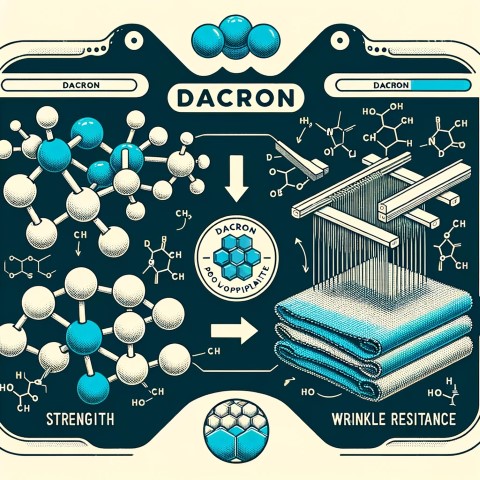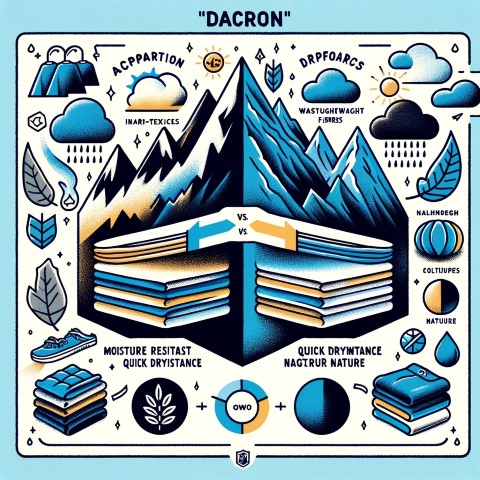Last Updated on: 04-Jul-2024 (23 days ago)
Share on Facebook • Share on Twitter
Dacron's Secret: How This Polyester Outperforms in Textile Innovation
Dacron fibers are synthetic, meaning they are man-made rather than derived from natural sources. They are produced through a process called polymerization, in which ethylene glycol and terephthalic acid (or dimethyl terephthalate) are chemically reacted to create a polymer. This polymer is then spun into fibers, which can be further processed into various textile products.
One of the key advantages of Dacron fibers is their strength and durability. They have a high tensile strength, meaning they can withstand tension without breaking or stretching excessively. This makes Dacron ideal for applications that require long-lasting, resilient textiles, such as outdoor furniture, upholstery, and technical fabrics. Additionally, Dacron fibers have excellent resistance to abrasion, which contributes to their durability.
Dacron fibers are also known for their versatility in terms of fabric properties. They can be manufactured to have different characteristics, such as high or low stretch, stiffness, or softness, depending on the intended application. This makes Dacron suitable for a wide range of textile products, including apparel, home furnishings, industrial fabrics, and even medical textiles.
In the textile industry, Dacron fibers are used by a variety of manufacturers and brands. One prominent user of Dacron fibers is the furniture industry. Dacron is often used in upholstery fabrics and cushion fillings due to its durability and ability to maintain its shape over time. Many furniture manufacturers rely on Dacron to create comfortable and long-lasting seating options.
Another significant user of Dacron fibers is the apparel industry. Dacron is commonly blended with other fibers, such as cotton or wool, to improve the strength, wrinkle resistance, and shape retention of fabrics. It is frequently used in garments like shirts, pants, dresses, and sportswear, providing a balance of comfort, performance, and durability.
Furthermore, Dacron fibers are utilized in technical textiles, which are fabrics engineered for specialized applications. Technical textiles can be found in industries such as automotive, aerospace, construction, and healthcare. Dacron's strength, resistance to chemicals, and thermal stability make it suitable for applications such as airbags, seat belts, geotextiles, and surgical gowns.
As for manufacturers, DuPont, the company behind the development of Dacron, remains a prominent player in the production of polyester fibers. However, numerous other companies have entered the market and produce Dacron-like polyester fibers. Some notable manufacturers include Trevira, Reliance Industries, Indorama Ventures, and Teijin. These companies have extensive experience and expertise in polyester fiber production, supplying the textile industry with high-quality polyester fibers for a wide range of applications.
In conclusion, Dacron is a durable and versatile polyester fiber widely used in the textile industry. It offers excellent strength, resilience, and fabric properties, making it suitable for applications ranging from upholstery and apparel to technical textiles. With its long history and established reputation, Dacron continues to be a preferred choice for manufacturers across various sectors of the textile industry.
Trade name for a polyester fibre. It blends well with other fibres, can be bleached and takes dye well. Used mainly in the manufacture of clothing, curtaining, furnishings, and fillings for pillows and quilts. Washes well and drips dry, as the fibre does not absorb moisture. A variety of types are developed to meet divergent needs; like, a low-pill fibre meant for light fabrics, thin wadding fibre suitable for padded clothes, a very fine weft fibre for sportswear and leisurewear fabrics, etc.
Some more terms:
Hydroextraction
The process of removing large amounts of water from fabrics after dyeing using either industrial spin dryers or vacuum extractors. They reduce the amount of energy required in stentering or other...
Read about HydroextractionStain resistance
Stain resistance is a wet, usually semi-durable finish applied to a fabric in order to resist the penetration of a liquid stain substance while allowing the passage of air and moisture. The finish...
Read about Stain resistanceElectrical conductivity
Ability of a fiber or fabric to carry electrical charges. Fabrics with low conductivity build up static electric charges and can cling or produce static shocks. Cling and conductivity are also...
Read about Electrical conductivityTo the trade
Policy where furniture, fabric, lighting or wallcoverings are sold exclusively through or to retailers, upholsterers, designers and architects at wholesale showrooms. Retail clients may sometimes be...
Read about To the tradePigment printed
An insoluble colorant is printed on the fabric as a paste or emulsion, heat cured and bound to the fabric with resins or binders. Allows for the printing of fabrics with fiber blends that would be...
Read about Pigment printedBean Stitch
A type of running stitch composed of three stitches placed back and forth between two points. Often used for outlining because it eliminates the need for repeatedly digitizing a single-ply running...
Read about Bean StitchAdhesives
Adhesives are an essential part of the manufacturing process for a variety of apparel applications ranging from applying labels, decorative trim and waterproofing tapes to innovative solutions like...
Read about AdhesivesGeorgette Fabric - Unveiling the Ethereal Elegance.
Georgette is a lightweight, sheer fabric with a unique texture and drape. It is widely used in the textile industry for creating elegant and flowing garments. This article aims to provide a...
Read about GeorgetteAdd a definition
- The term you want to define
- Its definition in 500 words or less
- Attach an image if necessary.
- Optionally, tell us about yourself in 200 words or less!
Companies for Dacron:
- Company name
- Company address
- Attach a logo, if necessary.
- Optionally, tell us about yourself in 200 words or less!

 The textile industry in Bangladesh is a major source of foreign exchange.
The textile industry in Bangladesh is a major source of foreign exchange.

